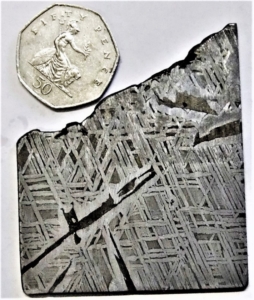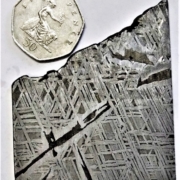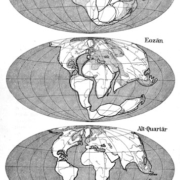Widmanstatten meteorites
Article by Dr Fred Starr PhD, FIMMM, FIE, MIMechE, CEng
In an earlier posting I mentioned the barely explicable Widmanstatten structure, seen in the iron-nickel Marburg meteorite, which was found by local people as result of Alfred Wegener offering a reward. Although a good deal is known about the Widmanstatten pattern or structure, I want to explain, why, in my view, there are some unanswered questions.

Etched section from part of a meteorite discovered near Muonionalusta, northern Sweden
To see the Widmanstatten structure one must take a slice from the meteorite, grind and polish the surface so it gleams like a mirror, and then gently etch it using a weak solution of nitric acid, dissolved in alcohol. The underlying structure is then visible to the naked eye. It has the appearance of a pattern consisting of fine strips of paper laid on top of one another. Sometimes the strips are at right angles. Other times they can be at 30° or 60°.
The German Professor, Fritz Heide, published the “Kleine Meteoritenkunde” in 1934, one of the first books on meteorites. It was subsequently brought up to date by Frank Wlotzka and translated into English in 1994. Although missing more recent accounts of meteor phenomena, and in situ investigations of the asteroids and planets, it remains one of the standard works on the subject. Nevertheless, this book, and what I have read on the internet, doesn’t really tell us where Widmanstatten meteorites come from. Heide and Wlotzka were more interested in the stony meteorites, that are much more common.
My nine-to-five job
I have a professional interest in this matter, since as a metallurgist, I learned about “Widmanstatten in steel” in the first year of our university course. It is a microstructure that is produced by the incorrect heat treatment of some kinds of steel, resulting in poor ductility and impact properties. But what is the heat treatment of steel, and what is it doing? Why is it important? How is it related to what we see in iron-nickel meteorites?
Heat treatment of steel is possible, since in simplistic terms, iron exists in two crystalline forms, with the atoms in the crystals being packed together in different ways. That which is stable at high temperature, we call austenite. The other, ferrite, the magnetic form of iron, is stable at temperatures below about 700°C. The cooling that a steel “sees”, during heat treatment, gives the atoms time enough to move around and change position, adopting to the crystalline shape of ferrite.
A virtue of the high temperature form is that it is able to “dissolve” other elements. The lower temperature form, is not so willing. The result is, below 700°C, as well as the ferrite forming, we get a range of other crystals (usually compounds of iron and another element), that greatly enhance the strength of steel. Heat treatments normally start with the steel being at bright red heat. The time to get down to room temperatures ranges from a few minutes to a few hours. But most of the action, whereby the atoms can move around, will take place between 500 to 800°C, this period being quite short. The time is even shorter when the deadly Widmanstatten forms in steel.
Not such a meteoric rate of cooling
The structure that Widmanstatten found in his meteorite is the result of a low temperature iron rich alloy, called Kamacite, precipitating out of another sort of alloy of nickel and iron, called Taenite, as the temperature drops. In a sense the two crystalline forms abhor one another, but they split amicably, the Kamacite forming plates along selected crystalline planes in the Taenite. But the splitting process takes even longer than any Brexit negotiator could imagine. A harmonious relationship takes time to develop.
In contrast to the heat treatment of steel, where everything is over in a few minutes, the size of the Taenite and Kamacite plates, which in steel making terms are gigantic, tells us that the estimated rates of cooling were somewhere between 1 and 100°C per million years! Even at high temperature, the known rates of movement of iron and nickel atoms are very slow.
It’s like a huge crowd of closely packed people, wearing two sorts of uniform, blue and red. When the bell rings they are told to sort themselves into columns, ten abreast. But in one set of columns there is one blue uniform to every nine red unforms. In the other set, nine red to every blue. Since the crowd is jam packed, it takes ages for the people to get sorted out in discrete columns. So it is with the iron and nickel atoms in the meteorite.
Dumb metallurgists
European metallurgists consider their opposite numbers from England and America as being especially dumb, since they cannot spell Widmanstätten in the German way. Or pronounce it properly.
More seriously, here is the quandary. Even a big boulder-sized meteorite, where we might find Widmanstatten, would cool down thousands of millions of times too quickly for the plate like pattern to form. As someone who worked in a steelworks, I can tell you, from seeing what happens to four-ton, red hot ingots, these are down to room temperature in less than a day.
When over zealous metallurgists have tried to heat treat precious Widmanstatten meteorites, they have not been popular. The criss-cross structure disappears. Having formed Taenite at high temperature, on cooling, the atoms have no time to rearrange themselves. The Taenite is frozen in place.
Where do Widmanstatten meteorites come from?
Widmanstatten meteorites must have come from planetary or asteroid bodies which were largely composed of iron and nickel and have been around for a very long time. One guesses that what we are seeing is a consequence of collisions between small lumps of debris, which must be common in the asteroid belt, and big metallic asteroids. The speed of collision would not be high, just enough to fracture the surface, resulting in pieces being flung in all directions. This would have preserved the original microstructure.
There is plenty of iron and nickel around in the Solar System. Mercury is the best example, being almost completely metallic, apart from a very thin rocky skin. Earth too has a molten metallic core, giving us our protective magnetic field. Furthermore, radar observations from the Earth show that there are some reasonably sized metallic asteroids, the biggest being 16 Psyche, which is about 200 km in diameter.
If an asteroid the size of 16 Psyche had been made just of iron and nickel, it would have cooled down far too quickly, from the molten condition, for Widmanstatten to form. Back in Victorian times, Lord Kelvin (a title bestowed upon Britain’s most eminent engineer/scientist) had done a similar calculation for the Earth. He estimated it would take a mere 30 thousand years. He didn’t know of the radioactive elements that keep Earth metallic core molten and give us volcanoes. Radioactive elements would be needed to keep Psyche, not molten, but in the critical 700-500°C range for millions upon millions of years. We need to look for these.
Nasa plan to launch a space mission to 16 Psyche in August, next year, which will have to be a go-no date, as the mission profile will involve a flyby of Mars and gravity boost from the planet. Getting close to an asteroid is difficult. Asteroids are small so spacecraft cannot use gravity to slow them down, once they get there. Arrival time will be 2026, but again, because of energy considerations, all that that Nasa plan to do is to put the spacecraft into orbit round Psyche for a number of months. There is no prospect of a landing.
Until we actually get onto Psyche or another metallic asteroid, and cut and polish to reveal the microstructure, we won’t be able to say whether these bodies are indeed the source of Widmanstatten meteorites. One wonders however, whether Widmanstatten and Wegener, are up there, already, among the stars, so to speak. If they are, they must know already!
Further writings and publications by Fred Starr are available online at FredStarr.com
Editor’s note
Widmanstatten meteorites were named after Count Alois von Beckh Widmanstätten, an Austrian printer and scientist, who discovered the metallographic patterns in 1808.






I witnessed a meteorite fall very close to me.i have info on it Google”sio2 59.32″ .it is a stoney meteorite that has a widmanstatten pattern on exterior.to me the pattern is the same as the gibeon meteorite ball pic.sio2 59.32 also brings up mars meteorite